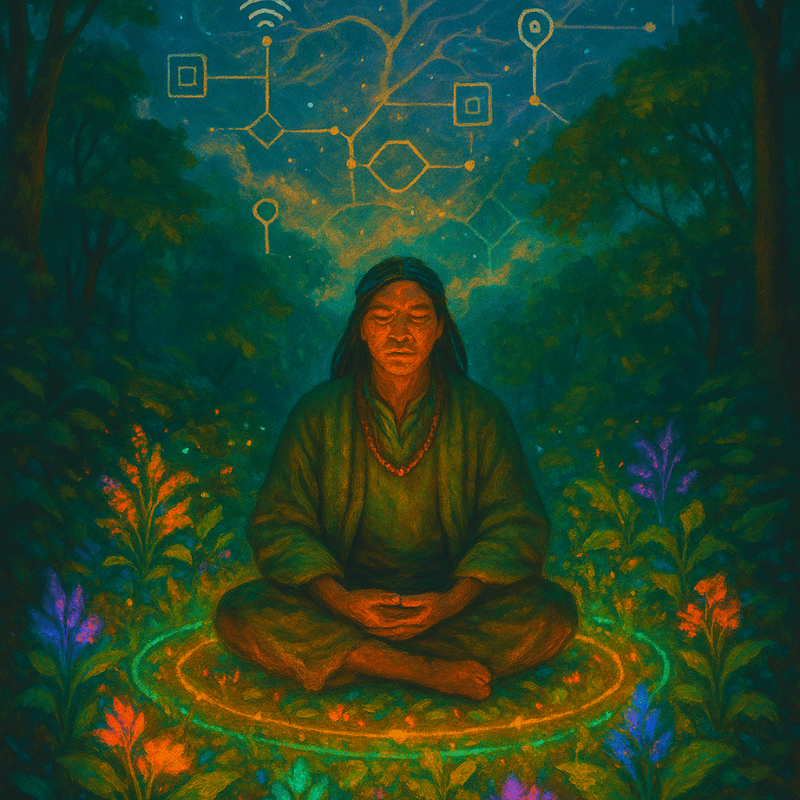The closing of a year is traditionally is a time for reflection when we hear ‘auld lang syne’ in words or song. In honor of ringing in the New Year, we share our guest writer, Kübra Özgüvenç’s, blog and the meaning of auld lang syne (times long past) with you. Our New Year’s intention further connects that of the old long past, ancestral knowledge, and rediscovered ancient wisdom as a practical resource for our modern times. We are thankful to Kübra’s insights and committed service for humanity along with others of our global community. It is our hope that you find this article as an entry point or as a fresh reminder to compliment and accompany you into 2024!
In the hustle and bustle of modern life, there’s a growing fascination with ancient practices that promise inner peace and well-being, especially these days when we are chased by our personal lions. What’s truly intriguing is that science is uncovering the hidden treasures within these ancient techniques — meditation, shamanic drumming, and various other rituals — that our ancestors used for centuries.
Meditation: It involves focusing the mind to achieve a calm and stable state. However, it’s a common mistake to believe that meditation means standing still and not thinking anything to clear your mind. In fact, it was supposed to be the opposite in the beginning. We all have a limited data processing capacity.
In the past, there were only certain ways to receive information: daily news, family and friends’ gatherings, festivals, and, more recently, TV or radio broadcasts. But today, we expose ourselves to data anytime, anywhere, leading to an overload that diminishes our processing capacity.
Therefore, to increase your data processing capacity, it’s essential to process your daily inputs, outgrown information, and emotional data during meditation. Allowing yourself to think about what comes to your mind at the beginning of your meditation can promote the Zeigarnik Effect.
For those unfamiliar with the Zeigarnik Effect, it describes the unfinished tasks that linger in your mind, similar to having multiple open web browsers, slowing you down and impeding achievements as your mind becomes a center of turmoil.
So,
if burnout seems at hand,
if your life feels out of control or
if you struggle with stress management,
I highly recommend starting daily meditations without constraining them. Allow thoughts to flow as they wish. Don’t attempt to focus on or avoid anything. Become the thought itself, and you’ll find yourself at a very different point than where you began.
Also, recent studies using brain imaging technology have revealed remarkable changes in brain activity during meditation. It seems to promote neuroplasticity, enhancing areas related to emotional regulation and attention. People who regularly practice meditation report reduced stress, improved concentration, and enhanced emotional resilience.
Shamanic Drumming: Diving into the realms of shamanic cultures, the rhythmic beating of drums holds profound significance. Not surprisingly, scientific studies have found that drumming at specific tempos can induce altered states of consciousness. Thus, by listening to these rhythmic sounds, you can alter brainwaves and activate different mental and physical abilities.
Altering brainwaves leads to relaxation and a sense of connectedness. This practice is believed to facilitate healing and self-discovery as it promotes changes in alpha and theta brainwave levels, initiating the body’s self-healing journey.
Breathwork and Pranayama: Ancient breathing techniques, like Pranayama in yoga, emphasize the power of breath control. Modern science has shown that these practices can influence the autonomic nervous system, affecting heart rate, blood pressure, and stress levels. Controlled breathing techniques have been linked to reduced anxiety and improved mental clarity.
Mindfulness: Rooted in Buddhist traditions, mindfulness emphasizes awareness of the present moment. Research indicates that practicing mindfulness can rewire the brain, leading to better emotional regulation and decreased rumination. Similarly, Tai Chi, a Chinese martial art, has been associated with improved balance, flexibility, and reduced stress.
The Science of Sound Healing: Across cultures, sound has been used as a healing tool. Scientific investigations reveal that certain frequencies and vibrations can affect brainwave patterns, inducing relaxation and aiding in pain relief.
These revelations from scientific studies shed light on the tangible benefits of these ancient practices. They’re not merely relics of the past; they’re becoming recognized as powerful tools for enhancing mental and physical well-being in our modern world.
As we navigate the complexities of contemporary life, these ancient practices offer a pathway to inner harmony, resilience, and a deeper understanding of ourselves. Embracing these ancient techniques might just be the key to unlocking a healthier, more balanced way of living amidst the chaos of our times.





